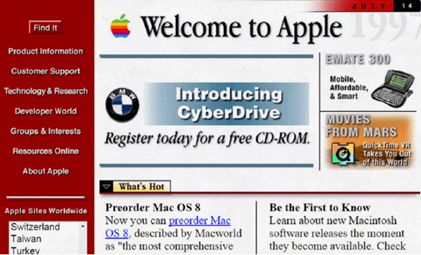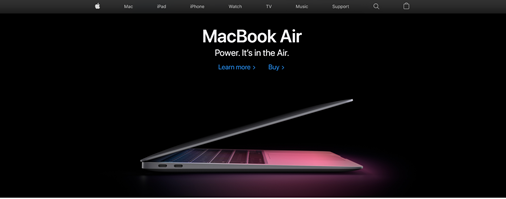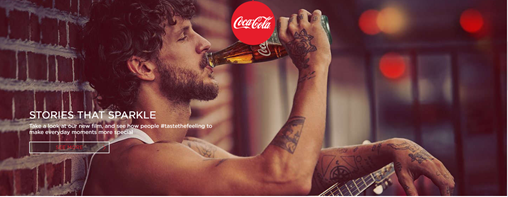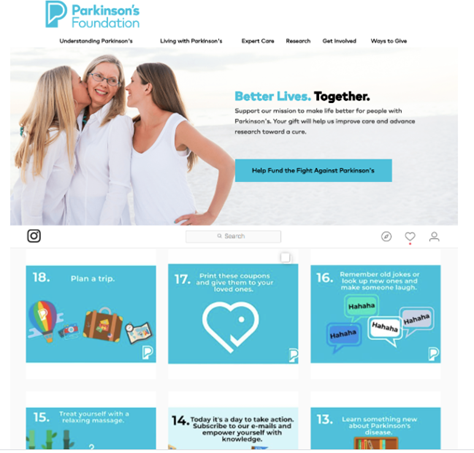Here’s a startling fact: worldwide, there are now more photographs taken every two minutes than were taken in the entire 19th century.
With an average of 60 million new images posted to Instagram alone every day, it’s fair to say that we live in the age of the image.
But what does that mean if you’re tasked with choosing images for your website? Here are a few things I’ve learnt.
1. It’s a mistake to think about words and images in isolation
You might think that as a Digital Copywriter, choosing images wouldn’t be part of my remit. Once upon a time, you would have been right.
When the internet was in its infancy, the role of the copywriter was to, well, write copy. Not a whole lot of thought went into how to present that information on the page, but to understand how things have changed, take a look at these two versions of the Apple homepage; the first from 1997 and the second, a screenshot I took a couple of days ago.

Apple homepage, 1997

Apple homepage, 21st November 2020
What do you notice? Far, far fewer words and far, far greater importance placed on the image that’s chosen, yes?
Now take a look a look at these two versions of the Coca-Cola homepage.

Coca-Cola homepage, 1999

Coca-Cola homepage, 2020
The same thing.
As digital capabilities have developed, so has our understanding of how people use websites. And so the job of the Digital Copywriter is no longer just writing the most effective words, but also presenting them in the most effective way.
Anyone designing content for a web page now needs to think, not just about the words and not just about the images, but how they work together.
Personally, I can’t get enough of shaming 90s websites, so here’s another one, to hammer home my point. I know, right? How was it possible to become Jeff-Bezos-rich with a website that terrible?

Amazon homepage, 1995
2. Images bring value to your words and words bring value to your images
When designing content for your website, you’ll probably be thinking:
- How can I best get my message across?
- How can I best direct the user to the content they want to find?
- How can I best direct the user to the content I want them to find?
- How can I convey to the user who I am, what I do, who I do it for, and what makes me different in the eight seconds the average user stays on your website landing page?
Of course, lines of text are still part of the answer to those questions, but not every visitor will take the time to read everything you write (as much as it pains me as a copywriter to say it).
Remember, you only have eight seconds to make an impact. Adding a picture that evokes an emotional response, like that pink glow emulating from the slightly open and oh-so-desirable MacBook Air, can pack far more of a punch than 8-seconds’ worth of reading time about the technical spec of the MacBook could do alone.
3. Images do more than just make your site look nice
Instagram, the photo and video-sharing social media app that now boasts one billion active monthly users, has a per-follower engagement rate reported to be 58 times higher than Facebook’s and 120 times higher than Twitter. And its users are two and a half times more likely to click on ads than on any other social media platform. What does this tell us?
It tells us that the science is right.
- We humans are highly responsive to imagery
- Our brains are tuned from birth to give meaning to visual information
- 90% of all information that we transmit to our brains is visual
- People often remember visual information far more easily and for far longer than other forms
- Images cross language barriers
- Images cross social barriers
- Images attract our attention and guide our line of sight a certain way
- Visual information is very convenient – it scans easily
And it tells us that we all need to pay far more attention to the images we use as marketeers.
4. There might be more images out there than ever before but it does not mean your job is going to be easy
Never before has it been so easy to get your hands on ‘the perfect image’.
In theory.
There’s Shutterstock, there’s iStock, there’s Unsplash, there’s Kaboompics, there’s Google Street View, there are bespoke photos taken by professional photographers, there’s your good ol’ iPhone… how hard can it be to get a cracking good shot?
Yep, still really hard.
Here are just a few of the problems I’ve encountered after thinking I’ve found the perfect image:
- The image resolution isn’t high enough
- The colours used within the image clash with the site colour scheme
- Someone else has used the same stock photo on another website and now we look like we’re copying
- The photo looks ‘too stocky’ when placed next to other more natural images
- The link to the content is too tenuous
- The actions and the energy are perfect, but the people in the photo don’t resemble the audience we’re trying to reach
- The photos used across the site aren’t all consistent – there are filters on some / the light isn’t the same / some are more grainy than others / the people aren’t all the same distance from the camera
- I’ve used one demographic of people too frequently so other groups are under-represented
- People featured in the photo must be standing on the right, not the left or their heads get cropped off when placed in the required triangular space
- The day the photo of the stunning office exterior was taken, the bins were left in view. The bins are purple and now I can’t take my eyes off them
- The image isn’t royalty-free
And, of course, not forgetting the problem that:
- Everyone else hated the picture.
Because finding ‘the perfect image’ is reliant on everyone involved in the decision-making process having the same understanding of what ‘the perfect image’ is. Images are subjective, as is the definition of ‘perfect’.
5. Don’t choose what you ‘like’ – choose what is ‘effective’
The ‘perfect’ image is not the one you like the most; it’s the one that’s most effective in achieving your aims. Since your audience will determine that, start with them.
What is important to them? What does their day look like? What do they aspire to achieve? And what do they look like? If you want them to form a personal connection with the material on your site (you do) they need to be able to recognise themselves and either the lives they currently live or the lives they want to live in the visuals they see.
Run some tests to see what resonates. Try two or three different styles and post images to your social media posts or blogs to see which gets the most engagement.
And always choose images that support your content, whether that’s through adding weight to a point you’re trying to make, or because they convey a feeling that supports your message.
6. Once you figure out what works, stick with it
Develop a distinctive style for your site imagery. That means keeping a consistent colour palette and mood through all your imagery. For example, dark colours and heavy fonts project seriousness; pale, neutral palettes can give a modern or even futuristic vibe. Keeping a consistent style helps create a feel of who you are and what you stand for that will run through everything and bolster your written messaging.
Remember, it doesn’t always have to be photography. You could incorporate illustrations, icons or doodles with your photography to bring added personality, warmth and a distinct style to your visual identity.

The Parkinson’s Foundation website uses illustrations alongside photography
Conclusion
An abundance of images in our lives has led to a far more discerning and demanding audience. Which means that you now need to work harder than ever to find a picture that really makes an impact.
Lazy, obvious images, or images chosen for purely ornamental reasons that lend nothing to the content around it, could potentially do your brand more damage than no image at all.
So, don’t just use an image to get rid of too much white space. When you do that, you’re losing the chance to tell your site visitors something about you, what you stand for and who you help.
Images can help us form personal connections, build trust and change our behaviour. They trigger emotions and memories and get us engaged in content. That’s a pretty effective way to use a bit of white space.


